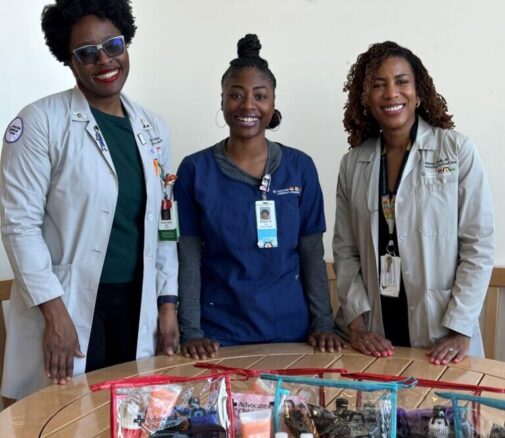The struggles and silver linings of two pandemics

It’s been a long year for Dr. Carmen Fotso, family medicine, who has not been immune to the tragic effects of the two pandemics plaguing the United States this past year — the COVID pandemic and the pandemic of racism. She, like many others, harbors worry for her family’s health because of the virus, and also for the wellbeing of her children, with whom she’s had to have candid discussions about race.
In the last year, she’s grieved over the loss of two family relatives in Cameroon who died because of COVID. She’s stressed about how she would care for her family and patients should she herself get COVID, and she feels survivors guilt of still having a job when many have lost theirs or cannot get one. She has had to take care of her children, all of whom are home and unemployed or taking virtual classes, and she has had to talk with her college-age black son about what to do if the police pull him over and worry about him being misunderstood or seen as a threat.

But she has also embraced this year, counting her blessings, like enjoying her practice colleagues, her patients and learning new skills due to the unique challenges of COVID. The biggest change was embracing virtual health in communicating with her patients.
“As a physician I was aware of Advocate Aurora Health rolling out virtual visits as a video option for our patients in early 2020, but we weren’t expecting the pandemic which quickly forced us to learn and use it on a daily basis,” said Dr. Fotso. “Now almost a year later I can’t imagine not using it as it has been such an amazing tool that I love to use with my patients! My patients have really embraced it, especially the younger generations, but baby boomers appreciate it too.”
Dr. Fotso is part of the Advocate Outpatient Center in West Dundee, which is committed to having an all-Spanish-speaking staff that takes care of the whole family. She and her team are often bridging the gap of mistrust, lack of care, education and health issues that are prevalent in the black and Hispanic communities that they serve. Some of those issues are diabetes, high blood pressure, obesity, high cholesterol, heart issues, etc. along with other health inequalities and care gaps.
“The health challenges we had before COVID are even more heightened like poverty, unemployment from loss of service industry jobs, uninsured and families living in crowded housing with multi-generational households,” she shares, “We just need to continue to make ourselves available and try to make sure there are no barriers to our patients receiving care with us by offering services at our location to be a one-stop shop.”
Dr. Fotso shares a few tips families and communities can use to address both pandemics:
- Talk with your kids about racism and COVID issues. Let them know it is okay to talk about differences and changes that have occurred from both pandemics so far.
- In school young children are learning inclusiveness and diversity. Be engaged with what your children are learning to help guide your conversations as a family.
- Have your children learn from history and why it is important today, so we don’t make the same mistakes
- Showcase different role models to your kids. Dr. Fotso’s daughter looks up to former President Barack Obama and her son is interested in government jobs.
- Get involved with groups that address racism and seek diversity, equity and inclusion. Dr. Fotso advises through an Equity focus group part of her daughter’s school district. Their goal is to boost and advance diversity, equity, and cultural responsiveness within the school district.
- Be self-aware. Notice any subconscious bias you may have, which you will have, and know you are learning to uncover them. Take advantage of any community and work education in these areas that can help you grow.
- Know that you can always listen and learn from someone who is different from you. Remove any barriers to understand each other. Dr. Fotso became fluent in Spanish thanks to her patients.
- Studies have shown that having a primary physician who looks like you improves health outcomes due to a similar background which helps to build trust and empowers patients to be comfortable in asking questions about their health. Find a physician who is a good fit for you and what you need.
- Less than 5% of all US physicians are Black. Encourage youth and adults who are interested in becoming a physician to pursue their dreams and support them through the ups and downs. Then in the workplace be recruit, hire and mentor more diverse providers that can represent your community and improve its residents overall health.
Click here for more stories about doctors, nurses and others working on the front lines.
Related Posts
Comments
About the Author
Jennifer Benson, health enews contributor, is coordinator of public affairs for Advocate Health Care and Aurora Health Care. She has 10+ years of community development and communication experience for non-profits and has a BA in Architecture from Judson University in Elgin, IL. Outside of work, you can find her planning the next adventure near water or rocks, re-organizing spaces, working on her Master’s in Public Health, caring for her senior citizen cat, keeping to healthy moving and eating disciplines and growing green things wherever she can find room.

















